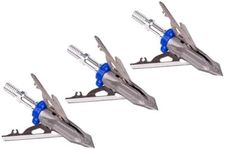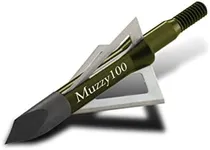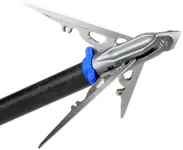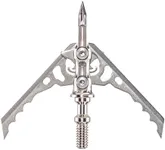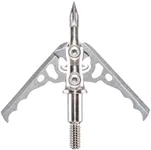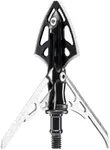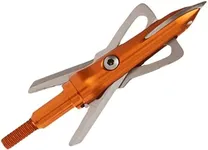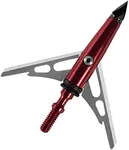Buying Guide for the Best Mechanical Broadheads
Choosing the right mechanical broadhead is crucial for hunters who want to ensure a successful and ethical hunt. Mechanical broadheads are designed to expand upon impact, creating a larger wound channel and increasing the chances of a quick, humane kill. When selecting a mechanical broadhead, it's important to consider several key specifications to find the best fit for your hunting needs. Understanding these specs will help you make an informed decision and improve your overall hunting experience.Cutting DiameterThe cutting diameter refers to the width of the wound channel created by the broadhead when it expands upon impact. This spec is important because a larger cutting diameter can result in more significant tissue damage, leading to quicker blood loss and a faster, more humane kill. Cutting diameters typically range from 1 inch to over 2 inches. If you are hunting larger game, a broadhead with a larger cutting diameter (1.5 inches or more) may be more effective. For smaller game, a smaller cutting diameter (around 1 inch) may be sufficient and can help with better penetration.
Blade CountBlade count refers to the number of blades on the broadhead. More blades can increase the cutting surface and create a larger wound channel, but they can also affect the flight and penetration of the arrow. Common blade counts range from 2 to 4 blades. If you prioritize a larger wound channel and are confident in your bow's power and accuracy, a broadhead with more blades (3 or 4) might be suitable. For better penetration and flight stability, especially with lower draw weight bows, a 2-blade broadhead could be a better choice.
Deployment MechanismThe deployment mechanism is how the blades of the mechanical broadhead open upon impact. This spec is crucial because a reliable deployment mechanism ensures that the blades open correctly and create the intended wound channel. There are various mechanisms, such as rear-deploying, over-the-top, and hybrid designs. Rear-deploying mechanisms tend to be more reliable and penetrate deeper, making them a good choice for larger game. Over-the-top mechanisms can create larger entry wounds but may be less reliable. Hybrid designs offer a balance between the two. Consider the type of game you are hunting and the reliability of the mechanism when making your choice.
WeightThe weight of the broadhead, usually measured in grains, affects the arrow's flight and penetration. Common weights for mechanical broadheads range from 100 to 125 grains. Heavier broadheads (125 grains) can provide better penetration and are often preferred for larger game. Lighter broadheads (100 grains) can offer faster arrow speeds and flatter trajectories, which can be beneficial for smaller game or longer shots. Match the broadhead weight to your bow's setup and the type of game you are targeting to ensure optimal performance.
MaterialThe material of the broadhead affects its durability and sharpness. Common materials include stainless steel, aluminum, and titanium. Stainless steel is durable and retains sharpness well, making it a popular choice. Aluminum is lighter but may not be as durable. Titanium offers a good balance of strength and weight but can be more expensive. Consider the hunting conditions and the type of game when choosing the material. For tough, large game, a more durable material like stainless steel or titanium is advisable. For smaller game or less demanding conditions, aluminum can be a cost-effective option.
